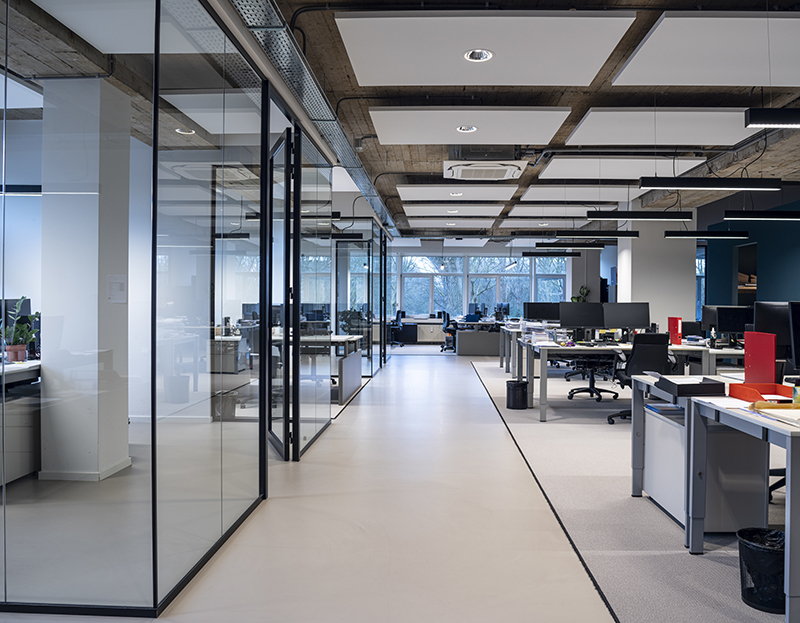Taking Back the Market | Equipping Glaziers to Compete in Division 10 | Part 2
The Product

Read Part 1 of Taking Back the Market | Specifications
Read Part 3 of Taking Back the Market | The Sales Process
The first article in this series explained how glass office fronts can be specified from the Master Specification as Division 8 or Division 10. More than $1.8 billion is sold through Division 10 annually, which means there are plenty of opportunities for glaziers to secure opportunities here if they understand the market.
Now we’ll be looking at the channels through which Division 10 products are sold, what qualities the A&D community values in these products, and what glaziers should consider in order to be competitive in Division 10 work.
Who Manufactures Demountable Walls?
As the market grows, competitors are flooding in with new product offerings. Those competitors can be grouped into four basic categories.
Furniture manufacturers
Furniture manufacturers typically source materials, fabricate either unitized or stick-built products, and sell primarily through their dealer network. They will occasionally sell direct to the end user on select projects. Furniture manufacturers leverage their national and regional furniture agreements to gain competitive advantage within an account. These agreement accounts represent the largest percentage of their revenue stream.
Manufacturer examples: Allsteel, KI, Fellows, Haworth, Steelcase, Teknion).
Demountable wall systems companies
Demountable wall systems companies fabricate their own products and sell them. Larger manufacturers sell through a furniture dealer network. Smaller companies use limited dealer distribution as well as direct end user sales.
Manufacturer examples: Muraflex, Maars, Infininum, Transwall, Fulkbult, DIRTT, Dhive, Nxtwall, Transwall.
High-end specialty manufacturers
High-end specialty manufacturers for demountable walls are typically European in design, most often from Italy. Large A&D firms such as Genzler or HOK specify these products primarily for high-profile projects, and the products are usually sold direct to the end user.
Manufacturer examples: IOC, Adotta, Optima, JEB.
Component companies
Component companies sell hardware, framing and/or glass for stick-built solutions. They package components together to create a demountable wall product that is then sold as a system. These companies are both national and regional. Many of these companies source part of their product solution from other manufacturers. They will sell through glaziers, authorized distribution or in some cases direct to the end user.
Manufacturer examples: Wilson, CR Laurence Dorma, Raco.
What Features Matter Most?
In the broadest terms, demountable walls can be placed on a grid that is defined by price and aesthetics. Typically, a lower-priced product will have less design appeal, while a product focused on high design aesthetics will carry a higher cost.
Demountable walls are usually designed in the United States or Europe. The biggest differences between U.S. and European demountable walls are profile and price. European product is generally significantly higher in price ($600-$800/linear ft. for material and labor), and utilizes very slim, low-profile extrusions. Most products manufactured in the United States are priced from $400-$650/linear ft. However, not all of them offer slim, low profile extrusions like the European brands.
A&D firms are highly concerned with aesthetics, brand and functionality. Price is a much less significant issue for them. The A&D community prizes the low-profile look of the European demountable wall products. They tend to specify European products on high- profile projects with significant interior finish budgets.
That being said, there’s a large continuum from the lowest cost to highest design appeal. In point of fact, there are more than 44 competitors in the demountable walls market. They all offer a different set of features and benefits in addition to price and design. Here are a few of the additional qualities glaziers should consider when looking at a demountable wall product.
- Acoustics. Generally speaking, a system should offer both single and double glazed options so that the right level of privacy can be created for each space. An STC rating of 33 to 34 is optimal for single glazed ½-inch clear tempered glass solution, and 42 or greater is optimal for double glazed installations (lite of glass/air cavity/lite of glass application).
- Lead time. The demountable wall market has traditionally offered somewhat lengthy lead times. New competitors entering the market are designing processes to create a competitive advantage in this category. The sweet spot is three weeks or less.
- Supply chain. A product manufactured and shipped from outside of the U.S. faces increased risk of shipping delays. Some manufacturers now stock extrusions and hardware to minimize this risk. It’s important to understand the complete supply chain when evaluating manufacturers.
- Self-leveling. The vast majority of demountable walls are sold for building updates and retrofits. It’s a pretty sure bet that walls and floors will not be perfectly square or plumb. A product with built-in leveling capabilities will make installation far easier.
- Universal hardware. A relatively simple glass wall can take on fresh aesthetics with the right hardware. The ability to accept hardware from most major manufacturers (ex: Dorma, Assa Abloy) extends the design aesthetic of a product.
- Specification and quoting. Having a simple and reliable tool for specifying and quoting a project can eliminate errors and provide timely quotes.
- Communication. This is perhaps the most overlooked aspect of the demountable wall installation process, and yet one of the most critical. Real-time updates on manufacturing and shipping are essential for coordinating on-time installation.
What Product Should a Glazier Consider?
Let’s come back to the four options we explored earlier in this article. Which ones would make sense for a glazier to consider?
Best opportunities for glaziers to benefit from Division 10
Component companies represent another very good opportunity for glaziers. Since their product is sold as a stick-built system, they rely on installer expertise to create an excellent end user outcome. Again, a glazier with a trained sales team and qualified installation team could find a good fit here.
Demountable wall systems companies do sell through distribution agreements. Although they often target furniture dealers, they would be more open to a conversation with a glazier because the glazier’s skill set fits their full product line. A glazier could definitely appeal to one of these companies if they had a sales team and could demonstrate excellent installation capabilities.
Additional Division 10 opportunities
High-end specialty manufacturers are going to be specified by A&D firms. Since the products are usually sold direct to the end user, a glazier’s only option is to be a preferred installer. This does represent a potential opportunity if the glazier can build excellent relationships with the A&D community as well as with general contractors. However, there will be no opportunity for the glazier to earn revenue from product sales.
Furniture manufacturers typically require a dealer to sign a distribution agreement, committing to an annual volume in a specific territory. They also want the distributor to sell their full line of products. It is highly unlikely that a glazier could be appointed as an authorized dealer for a furniture manufacturer such as Steelcase, Herman Miller, Haworth, etc.
Stay Tuned for the Final Chapter
The final article in this series will explain the sales process in Division 10. In addition to choosing the right products to sell, glaziers need to understand the influencers and timelines on projects in order to compete successfully and take back market share.


